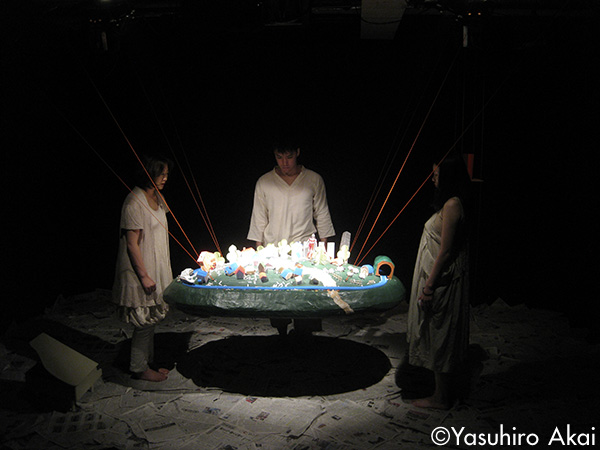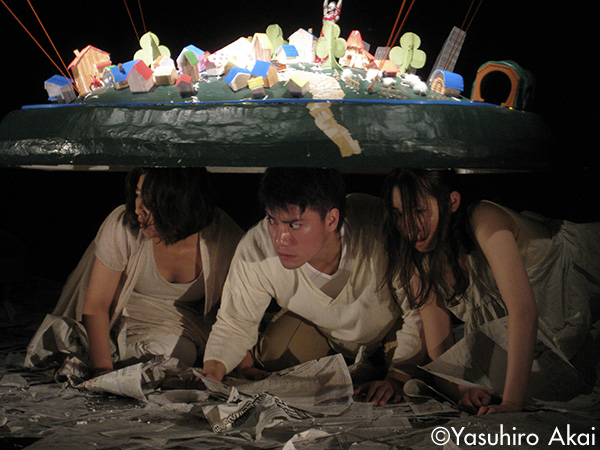In the center of the stage hangs a model of a town. Newspaper is scattered across the stage floor. Upstage in a bookshelf and downstage is a toy piano.
Woman 1 plays a time tone on the toy piano. Next, a man and Woman 2 rapidly read through a history of Fukushima, tracing backwards from 2010 as if they are in a race. They tell of heavy snows, drought, the opening of the Shinkansen bullet train line through the prefecture. The chronology ends with the 1970 start of operation of the nuclear power plant at Okumamachi as the first in the Tohoku region of northeastern Japan.
Women 1 and 2 and the man are searching for Uko-san. In the town where Uko-san lives there is a newspaper delivery man named Kiruannya who cuts up old newspapers, so there are newspaper clippings on the ground all over the town.
Although they all have the same name, it appears that the Uko-san the three are looking for are different people. Woman 2 is looking for a childhood friend named Uko who went to the same nursery school, while the man is looking for the chef of a bistro that specializes in home cooking. Woman 1 is looking for an idol-fan groupie friend she met over the Internet. When they list up the traits of the Uko they are each looking for, they begin to worry that she is nowhere to be found.
A book falls from the bookcase. Woman 1 picks it up. From the book,
Tono Monogatari
(Tale of Tono) a chapter about a man talking to the spirit of his wife killed in a tsunami is recited.
Another book falls. Next it is the man who picks it up and reads from it a poem by the poet Shimpei Kusano, who was an honored citizen of the town of Kawauchi-mura in Fukushima prefecture’s Futaba County. In the poem titled “Fukushima Prefecture, Futaba County, Kawauchi-mura village” the poet sings praises of his town. Yet another book falls. From it, Woman 2 reads the poem “
Juka no Futari
” (Two Under a Tree) written by the poet and sculptor Kotaro Takamura about his beloved wife Chieko and the beauties of her native Fukushima.
Returning to reality, the three begin their search for Uko-san once again. However, as they tell each other what they know about her, Uko’s identity it becomes less and less clear whether she really exists.
The three pick up clippings of newspaper lying at their feet and begin to read articles from them, starting with the date. The contents range from reports about a local film production to exchanges with a grandchild to a hula dance event, but the name of the person featured in each article is Uko-san.
When the articles that started with dates from January reach disastrous earthquake and tsunami date of March 11, an earthquake warning alarm suddenly rings. The startled three, who have been sitting under the model of the town raise their heads, they bump the model and the miniature town begins to shake. Now the articles they read are dated post-disaster and all deal with the disaster.
These articles tell about a Fukushima woman who had a baby at the town she evacuated to after the disaster, a Fukushima poet who publishes her poems on the Internet and the fact that the US weekly
Time
magazine has chosen the mayor of the Fukushima town of Minami Soma as one of its “100 Most Influential People.” But again, all of the people appearing in the articles are named Uko-san.
The final article the man picks up is a Fukushima Police Department list of the names and ages of missing persons from the disaster whose bodies have been found and identified. The three take turns reading the list. Again, all on the list have the same first name: Uko-san. Newspaper clippings fall on the model of the town.
Finally, Woman 1 plays the time signal on the toy piano and then starts playing haltingly the melody to the folk song “
Tanabata-sama
.” The man begins to play on a hand drum and Woman 2 begins playing an accordion. As they play, the man begins to read dates into the future: July 2011, August 2011 … January 2012 …. Woman 2 begins singing the words to
Tanabata-sama
.
The performance of the song and the accompaniment gains strength as the verses are repeated, like a requiem, like a solemn march.




